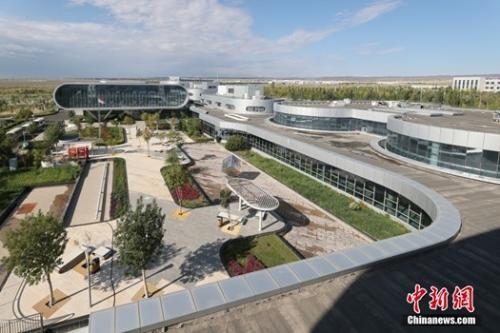From oil fields to GPU fields: How Xinjiang is powering AI development
By Luke Johnston
(ECNS) -- Want to see tomorrow being built in real time? Well, just drive a couple of hours north of the capital of Xinjiang Uyghur Autonomous Region, Urumqi, then take a turn off the desert highway, and you'll hit a view that looks like somebody dropped a row of Apple stores onto the surface of Mars. So perhaps Elon Musk would adore this city: Karamay. Once China's "black oil" town, is now auditioning for the role of Data-opolis in the next global AI blockbuster.

Cheaper electrons than a Starbucks coffee
Silicon Valley runs on coffee and stocks; Karamay runs on dirt-cheap electrons and free winter air. Coastal U.S. tech hubs pay roughly 0.63 yuan per kilowatt hour for juice. Out here it's 0.45 yuan. That 30% discount is the difference between powering a backyard drone and launching a satellite constellation.
And Mother Nature throws in a rebate: as well as strong sunlight providing green solar energy, well, for eight months each year, the Gobi wind turns server halls into natural refrigerators, allowing the continuously-running GPUs a chance to cool down for free.
In data centre slang, PUE is the scoreboard for energy efficiency: it tells you how much electricity gets lost on air conditioning, lights, and other overhead before it reaches the actual chips. A perfect PUE is?1—every watt goes straight into the GPUs. Karamay's latest halls boast a PUE of about?1.08. In plain terms, only 15% of the power is wasted on overhead here, roughly half the 29% drain you'll find in an average U.S. facility!
So how would I describe Karamay? Think Costco: everything in bulk, everything on the cheap—except instead of 25-kilo bags of rice, you get 25-kilo racks of GPUs.
"East data, West computing" — a new geography lesson

There's a trending phrase these days that any taxi driver could recite to you: "Use the data in the east, compute it in the west." Picture China as a giant extension cord: the coast plugs in data from its mega apps, and the desert lets it do all the fancy maths.
By the end of 2025, the Chinese government is aiming for 100?exaFLOPS of compute in Karamay. What does that mean? Well, picture a calculator (say a Casio) so fast it can solve 100?quintillion (that's 1 with 20 zeroes!) maths problems every single second—a behemoth of a calculator— it's as if every person on Earth was tapping away at a calculator 12?million times a second at the same moment.
Turning students into silicon
Six years ago, China had only 35 universities with an AI major; today the roster tops 630. Result: 47% of the world's elite AI researchers now come stamped "Made in China." Even Xinjiang University—better known for geology—opened an AI program and a GPU lab. I've watched first-year students who once Googled "What is backprop?" now argue about diffusion transformers the way football fans debate between Messi or Ronaldo (It's Ronaldo by the way).
Karamay is seriously building for the future, yet the problem is that not many people have heard of it. But that might be about to change…Karamay is now offering an incredible 15% tax holiday and a rebate if your company servers use green energy. Many startups are starting to pop up now in this small, remote city in the Northwest of China. In fact, some of China's tech-giants are starting to join the bandwagon, where Huawei recently built a 14,000-rack "intelligent computing" campus here; DeepSeek even trains a Mandarin Uyghur language model.
The future of AI is clearly in China, just nobody expected it to be here in Xinjiang one day.
Desert twilight, digital dawn

Translated into Uyghur as "Black Oil", this city was once famous for drilling oil to old factories. Today, it drills data to power everyone's TikTok feed.
Silicon Valley may still be where ideas are born, but Xinjiang is where they grow up, bulk up, and go to work. It is the Costco of computing, the cold storage locker for the world's AI ambitions. And if you think that doesn't matter to you, check your phone: somewhere in that swipe, click, or "Hey Siri," a little piece of Xinjiang is already working in the background.
The desert, once empty on the map, is now full of mathematics—and that changes the map for everyone.
The author is a PhD candidate in AI at Shanghai Jiao Tong University. The views do not necessarily reflect those of ECNS.

